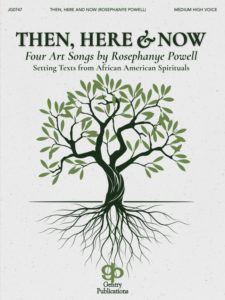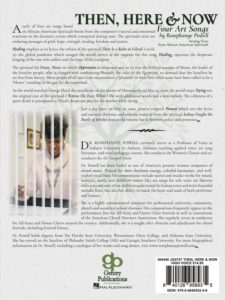Then, Here and Now
High voice:
- Then, Here and Now – High Voice | Gentry Publications
- Then, Here and Now – Four Art Songs by Rosephanye Powell Setting Texts from African American Spirituals – Gentry Publications | Hal Leonard Online
Low voice:
Videos:
Notes from the Composer
 Then, Here and Now is a cycle of four art songs based on African American spirituals. Each song reflects my visceral and emotional reactions to dramatic events which transpired during 2020. As I observed the worldwide responses to the outbreak of Covid-19, the death of George Floyd, and protests around the world, I became benumbed, emotionally exhausted. Tears were my daily companion, expressing what could not be uttered. In time, words came- -not my own–the words of the spiritual. Intuitively they came, the way my grandmother sang and hummed them as she struggled to breathe during asthmatic episodes, as a response to the death of a loved one, or just sat, Bible in hand. I hummed, sang, and wept, laden with waves of sorrow, the cycle repeating itself, seemingly without end. The words and melodies of the spiritual gave voice to my sorrow–just as they did for my grandmother and my ancestors during slavery. Thus, the title, Then, Here and Now, which refers to the spirituals’ enduring messages of hope, strength, healing, freedom, and justice.
Then, Here and Now is a cycle of four art songs based on African American spirituals. Each song reflects my visceral and emotional reactions to dramatic events which transpired during 2020. As I observed the worldwide responses to the outbreak of Covid-19, the death of George Floyd, and protests around the world, I became benumbed, emotionally exhausted. Tears were my daily companion, expressing what could not be uttered. In time, words came- -not my own–the words of the spiritual. Intuitively they came, the way my grandmother sang and hummed them as she struggled to breathe during asthmatic episodes, as a response to the death of a loved one, or just sat, Bible in hand. I hummed, sang, and wept, laden with waves of sorrow, the cycle repeating itself, seemingly without end. The words and melodies of the spiritual gave voice to my sorrow–just as they did for my grandmother and my ancestors during slavery. Thus, the title, Then, Here and Now, which refers to the spirituals’ enduring messages of hope, strength, healing, freedom, and justice.
 Because of their universal messages, it is my intention for Then, Here and Now to be performed and embraced by people of all races, cultures, nationalities, and backgrounds. My hope is that these songs will provide a sense of catharsis for both the performer and the listener. Each song is composed as a succinct statement of the main idea of the original folk song. As such, it does not utilize the entire spiritual–words, melodies, rhythms, harmonies, and form–which would be indicative of an arrangement or adaptation. In preparing these songs, I encourage singers to listen to and study concert arrangements of the original folk song for a deeper understanding and greater depth of expression. I have provided optional notes to make the songs more accessible to both developing and advanced singers. Additionally, the optional notes can provide varied opportunities for expression. The songs in the cycle can stand alone and be performed in any order which best serves the singer. Each song is dedicated with much admiration for and appreciation to a professional singer-educator who has been influential in preserving the African American spiritual and providing visibility for art songs by African American composers.
Because of their universal messages, it is my intention for Then, Here and Now to be performed and embraced by people of all races, cultures, nationalities, and backgrounds. My hope is that these songs will provide a sense of catharsis for both the performer and the listener. Each song is composed as a succinct statement of the main idea of the original folk song. As such, it does not utilize the entire spiritual–words, melodies, rhythms, harmonies, and form–which would be indicative of an arrangement or adaptation. In preparing these songs, I encourage singers to listen to and study concert arrangements of the original folk song for a deeper understanding and greater depth of expression. I have provided optional notes to make the songs more accessible to both developing and advanced singers. Additionally, the optional notes can provide varied opportunities for expression. The songs in the cycle can stand alone and be performed in any order which best serves the singer. Each song is dedicated with much admiration for and appreciation to a professional singer-educator who has been influential in preserving the African American spiritual and providing visibility for art songs by African American composers.
I. Healing employs as its lyrics, the refrain of the spiritual There Is a Balm in Gilead. Covid-19–the global pandemic which ravaged the world–serves as the impetus for this song. Healing expresses the unyielding hope of both the one who suffers and the caregiver. The introduction, measures 1-4, represents the desperate heart-cry of the sufferer who hopes for healing and the voice of the caregiver who encourages the sufferer to persevere. The piano and voice play an equal role in expressing the text as the piano doubles the voice in addition to serving as harmonic support.
In measures 5-9, the piano plays an interlude which represents the trickle of the healing balm (medicine) which grows into a river of balm for the healing of the sufferer. The flowing of the balm continues in the RH of the piano throughout the song while the LH expresses the depth of the healing with whole notes in the lower range of the piano. The piano joins the voice in expressing the text by singing the refrain “a balm in Gilead” with eighth notes in the upper range after each sung phrase. The piano makes the final statement of the text as it echoes “the troubled soul” in the LH of measure 16. This is followed by a gradual molto ritard in the final measure which represents the slowing flow of the balm to a trickle and its halt upon healing of the sufferer.
II. Oppression is defined as the exercise of power in an unjust manner; or the experience of being heavily burdened to the point of feeling or being powerless to control one’s life. The spiritual, Go Down, Moses on which Oppression is composed, uses as its text the biblical account of Moses, the leader of the Israelite people, who is charged with confronting Pharaoh, the ruler of the Egyptians, to demand that the Israelites be set free from slavery. In the eighteenth century, the African American slaves used this story to empower themselves to resist slavery, boldly confront their oppressors and courageously attempt escape to freedom. Today, oppression is experienced in the form of bullying, domestic violence, human trafficking, and discrimination; as well as harassment, aggression and microaggression in the workplace, to name a few. Many of us have encountered a “Pharaoh” in our lives while some have been called to be a “Moses,” standing in the gap for others who are being oppressed.
In Oppression, the piano introduction (mm 1-2) and postlude (mm 26-27) represent the seemingly mundane life of the oppressed to the casual observer. In measure 3, the voice enters with an introductory command for the listener to be a “Moses” and actively engage in assisting the oppressed. “Egypt’s land” symbolizes the place, state of being, or circumstances in which the exploited find themselves. The introduction ends at measure 12, as the story’s narrative begins. At measure 17, the accompaniment takes on the musical flavor of a Middle Eastern dance to foreshadow the celebration that will occur when the oppressed are set free. The humming which begins at measure 23, represents Moses’s thoughtful consideration of the call. Will he (i.e., the singer or the listener) come to the aid of the oppressed? That is the question posed in the hum of measure 25. In the postlude (mm 26-27), Moses observes again the oppressed laboring under the watchful eye of the oppressor. What will be his response to the call? The singer alone provides the answer of “yes, no, or maybe” in the final hum through facial expressions and body language.
III. On May 25, 2020, I watched George Floyd die mercilessly on the streets of Minneapolis. As he cried out “mama!” with his last breaths, I wept and sang the spiritual, I Wanna Die Easy When I Die. Dying sets the original text of the spiritual with additional words and a new melody. The calmness of a quiet death is depicted in the simplicity of the vocal line which should be sung with ease. The voice is supported by a light and airy accompaniment which depicts a quiet, radiant morning. The brief, contrasting section, “Shout salvation as I fly, tell my mother not to cry,’’ should be sung strongly expressing Floyd’s desperate plea for his mother while dying.
IV. On May 26, 2020, “the walls came tumbling down” as peaceful protests grew violent in Minneapolis, MN, and around the world. Protest, which sets the lyrics and extracts rhythmic and melodic material from the spiritual Joshua Fought the Battle of Jericho depicts the intense battles between police and protestors through the fast and steady tempo of a piano accompaniment comprised of ostinato, agitated rhythms, strong syncopation, and accented chord clusters. Often, the voice is bolstered by the RH of the piano which doubles the vocal line in octaves. In measure 43, the walls of oppression are heard “tumbling down” as descending, chromatic eighth notes in the piano.
May these songs inspire us to be agents of healing and positive change for our communities, our country and our world…here and now!
